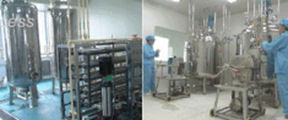Peruvian ginseng-Maca - Extract powders
Processing
The Lepidium meyenii plant is not a member from the Araliaceae family and is therefore not a real ginseng. Because some adaptogene actions are comparable with those from real ginseng, Maca is also called Peruvian Ginseng.The Maca roots are harvested and dried. After drying the Maca roots go into a carefully controlled extraction process with the desired concentration of glucosinolate or extract ratio as a result.
Because some active components of the Maca root only dissolve in water and others only in alcohol, a particular mixture of alcohol and water is used for extraction.
 |
A highly controlled processing method ensures that the dry Maca roots are processed into extract powders according approved standard processes. |
After extraction the alcohol is distilled from the liquid extract. Then the liquid extract is dried into an extract powder. This standard process ensures a Maca extract powder with the desired extract ratio or with the aimed glucosinolate content.
Composition of extract powders
Maca extract powders are only made from the roots of the Maca plant.Apart from some exceptions, almost all basic Maca extract powders are made without carriers or additives. At a customer's request a desired additive can still be added.
Packaging
For amounts less than 25 kg, Maca extract powders are packed per 1 kg in airtight aluminum bags with PE-inner layer. Bags with 5 kg are also available.Larger bulk quantities are packed in standard plastic bags in cardboard boxes or barrels.
Properties
Standard Maca extract powders dissolve not very well in water. With some adjustments in the production process it is possible to make extract powders that dissolve well in water.The color of most Maca extract powders is yellow-brownish.
The taste of Maca extract powder can be qualified as sweetish and tending to the taste of chocolate or vanilla.
Compared to the absorption of the active constituents from ground root powder, the absorption of the active constituents from extract powders is about double.
A possible practical disadvantage from Maca extract powders is that they are quite hygroscopic: they easy attract moisture from the air. When not preserved the right way the powder is at a high risk of clotting together. Keeping it dry in closed packaging is therefore vital.
Additives
To reduce the costs of the extract powder, adding filler is an option. The cheapest filler is ground rice flour.For other (process technological) reasons also other possible additives like: dicalcium phosphate, malto dextrin, silicon dioxide, magnesium stearate or glucose powder are used. Of course other additives, carriers or fillers are possible too.
Another benefit of adding filler to the extract powder is that it can drastically decrease the hygroscopic nature of the product.
Dosage
In-vitro-tests have shown that the absorption of active constituents from Maca extract powders is double the absorption of dried Maca roots or root powders. Counted in milligrams, this means that in order to get the same results a double dose of ground root powders is needed in comparison to extract powders.For a good result of Maca extract powders with an extract ratio from 5:1 it is advised to take 1-2 grams per day. For a therapeutic effect it is advised to take 4-5 grams per day of this powder.
From an extract powder with for example 1% glucosinolate it is advised to take 2-4 grams per day.
Practical experiences have demonstrated that activity and effects of Maca do not decline proportionally as a daily dose is lowered.
There is no dangerous (damaging) maximum daily dose, but 0,5 gram of concentrated Maca extract powder should be considered as a minimal dose. If you take less than 0,5 grams a day it will most likely not contribute anything.
When mixed with other medicinal herbs, a lower dose of Maca might be sufficient.
 |
 |
| previous | next |
